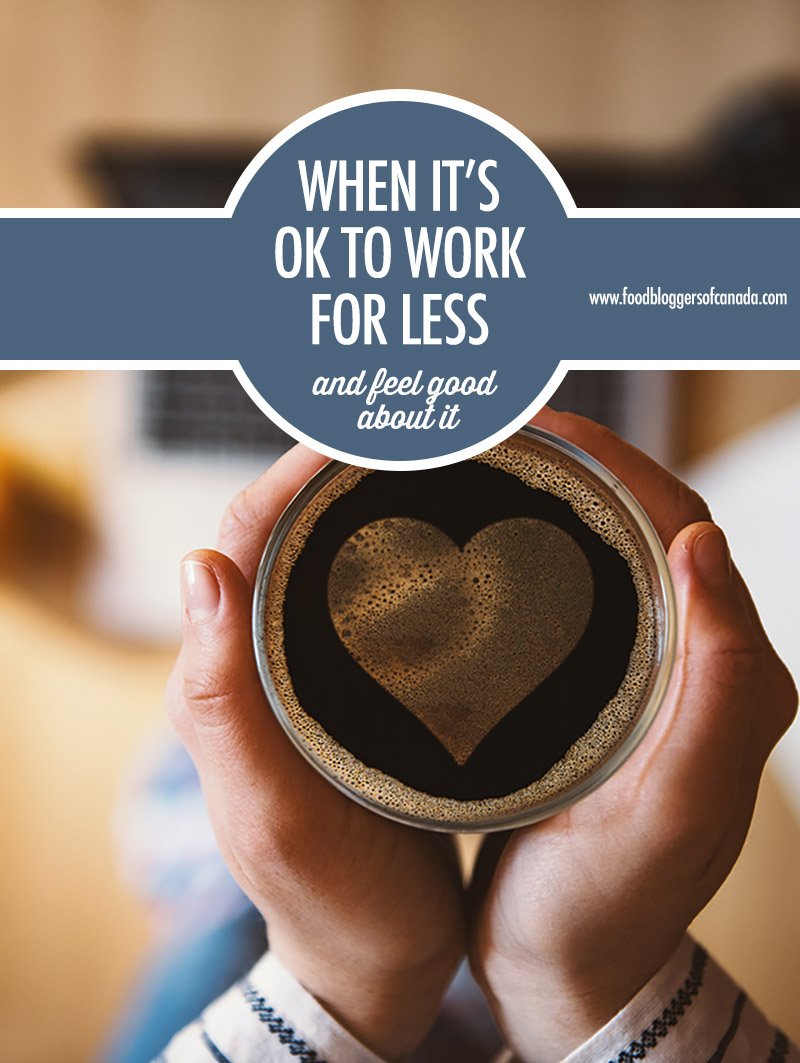Are there times when it's ok for bloggers or freelancers to work for less money than usual? Absolutely! When is it ok for bloggers to work for free? That depends on the blogger! But here are six scenarios where it's completely ok to work for less than your usual rate or even for free!

Working for free is a touchy topic in the blogging world. So is the idea of working for less than we feel we're worth. We're good at coming up with all the reasons we should say no to those scenarios. But what about saying yes to them? Are there ever times when it's okay to work for less? Or even work for free? And still feel good about it?
Absolutely!
This post is geared to the beginner blogger, but there are times where even the most seasoned of us can use a reminder that saying yes outside of our usual compensation rules can be a very good thing.
When you're first starting out as a food blogger, you don't have much to show the world. You're still trying to find your writing voice, your photography style and possibly even your food blog's niche. Your readership and social media reach probably aren't that big. All those things take time to develop - often years rather than months.
Here are six scenarios where it's totally ok to work for less money as a blogger or freelancer. And for some of them, it's even ok to work for free!
1. Building a Body of Work
Brand opportunities can be few and far between in those early blogging days. And when they do come, they probably don't offer much in the way of compensation.
But these early opportunities do offer something: a chance to experience working with brands and building a small portfolio of sponsored work that you can show other clients. That can be invaluable.
A few do's and don'ts:
- Don't work with brands or products that you don't like or that don't fit the values of you or your blog. If something makes you feel "icky" say no.
- Do overdeliver and show the brand how amazing you can be.
- Do make notes after the campaign about how you created value for the brand and their consumer. This will be useful for when you do raise your rates and you have empirical data that shows what you bring to the relationship (this includes stats, social media shares, and anything that went viral).
2. Getting Your Foot in the Door
When you're just starting out, don't expect the big brands to come knocking on your door. You're going to need to reach out (we have great tips on how to make contacts and build relationships here and here).
If you make contact, don't be afraid to work for less if it means the opportunity to build a long-term relationship. If your usual rate is $200, offer to do an initial post for $100. Let the brand know this is a discounted rate for new clients, but moving forward you'll charge your regular rate (and be sure to let them know that you're going to do such an awesome job for them that you're sure they'll see you're worth it!).
Working for free is also a great way to build your network, which is crucial in your early days. The really great opportunities often come from people who've met you and like what you do. If something interests you or offers an opportunity to work with somebody you've always wanted to meet, take it!
3. Non-Profits, Education and Children
I have a personal rule that I never charge a public school or a child doing a school project for the use of one of my photos as long as the work isn't going to be sold for profit. It's good will and, frankly, fun to see what kids and schools do with your content.
There's also a standard practice in the design community, where I come from, to have a different rate for non-profit groups where budgets are often smaller. This can easily apply to the blogging world. However, let me be clear here. Non-profits may have small budgets, but they do have budgets. I don't advocate working for free for a non-profit except for one very important reason: their cause speaks to you in a way that you know you have to help out, regardless of the compensation.

Those are three standard reasons for working at a lower rate or for free. Here are three more less talked about reasons:
4. Learning What Your Time is Worth
When you start out, it's hard to determine what your time is worth - or how long things will take. One thing to remember is that client work often takes longer and has more complexities than working for yourself.
When you write for yourself you know what you have to do: create recipe, shop, cook, plate, photograph and promote. It might take you 4 hours. And you may think $200 for 4 hours of work is pretty great (and it is a very decent rate).
On a paid gig you'll need to do all those things... and more. You have to allow admin time for brand communication, invoicing and stats reporting. The client may have specific requirements that make your regular process take longer. Now that post takes 8 hours. That $200 still isn't bad but it took you twice as long as you thought it would to earn it.
When you first start out, you'll need to take a few jobs to get a handle on how long a paid gig takes you and sometimes, taking lower paying jobs is the only way you'll get the opportunity to learn. But it's an important process to go through because once you get a handle on how long certain tasks take, you can negotiate.
If a client wants 4 photos but you know taking photos is the most time consuming part of your process, then counter with 2 photos but 3 extra tweets and an extra facebook post - which may only take you 10 or 15 minutes.
5. Learning What You Want to Do and What You Don't
The best thing I've learned from taking low paying gigs throughout my career is finding out what I love to do and what I hate doing!
I love branding so much I would practically do it for free (but I don't, because I have to pay my bills, I value my skills and my time and my clients should too). But I hate doing tech support so much that nobody can pay me enough to do it - and so I don't do it anymore! I apply the same logic to my blog - I'm not fond of recipe development so I charge more for it than most people would.
But to learn these things, I had to do them - more than a few times! And the less money I got paid, the clearer it became what I really enjoyed, what was worth my time and what I could really care less about.
6. A Passion Project
I've worked for free many times because I fell in love with the project idea and knew I had to be a part of it. And it's always been worth it. If something speaks to you and you know you were meant to do it, trust your gut and go for it. Don't worry about the money too much. Some of those passion projects can turn out to be your best paying jobs in the long run!
Working for a low rate or for free doesn't have to be a bad thing. It can be one of the best decisions you ever make for your career. But only you can decide when and where it's the right thing to do for you.
More Reading
- A Blogger's Guide To Determining Your Value
- A Blogger's Guide To Knowing When To Raise Your Rates
- Why Small Blog Numbers Are No Big Deal








Great post Melissa. As a pro food stylist and recipe writer, the most satisfying projects I’ve worked on have been jobs I’ve been passionate about, many of which I’ve done for free. Those free jobs, where the payment is evidence of your capability, often lead to more work than you can imagine. Asking to be paid for everything is myopic and an oversimplification of how freelancing works.
Thanks Christopher. I think that a lot of who come from creative freelancing backgrounds where you tend to traditionally pay your dues by working for free to build your portfolio tend to be very aware that those are some of the best gigs we ever had for that very reason – we got to work on things we never would have otherwise and we got to work for and with people who might never have given us a second glance. And those pay back in dividends in the long run – that concept sticks with you!
Thank you for this encouraging and helpful advice!